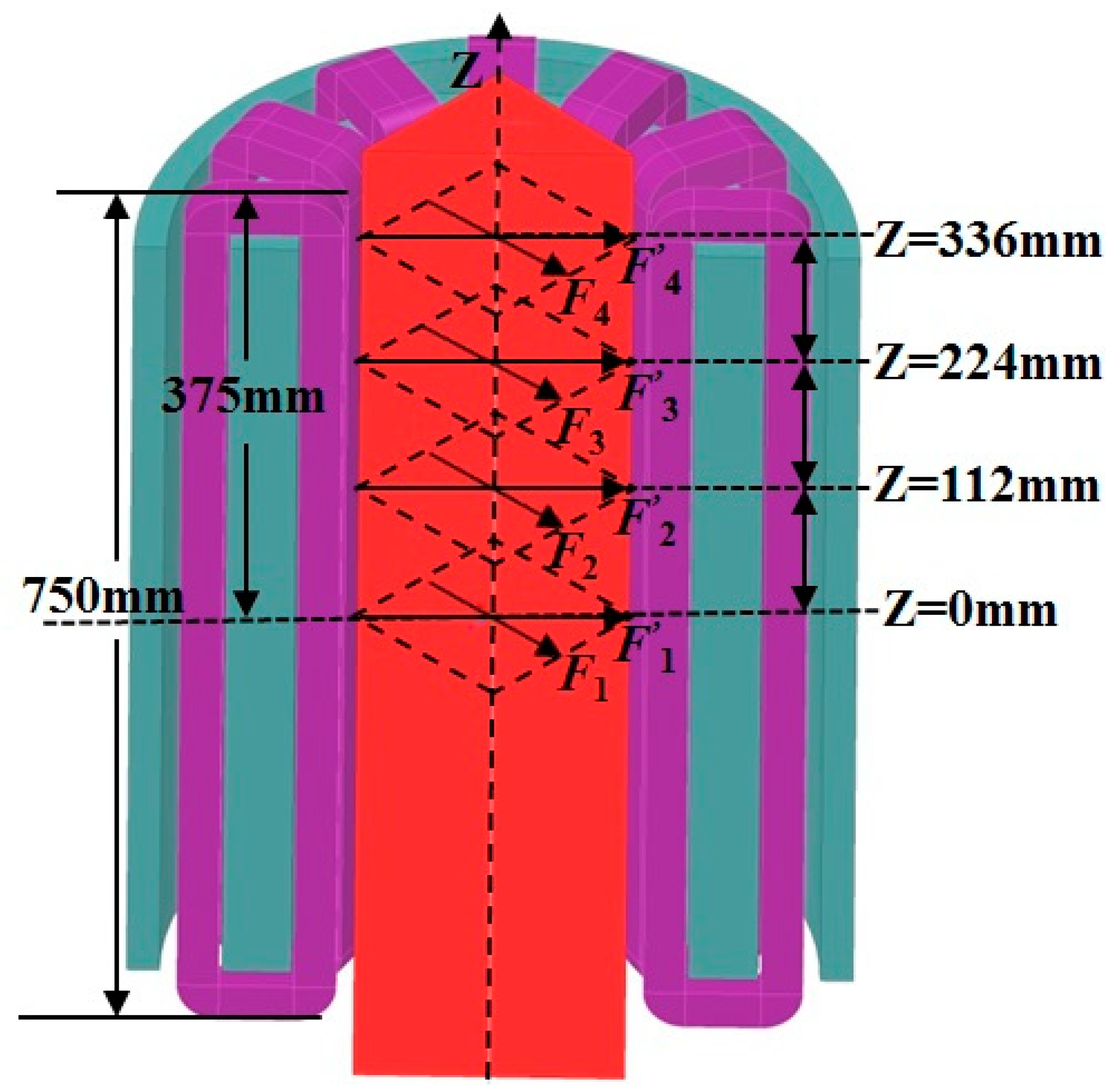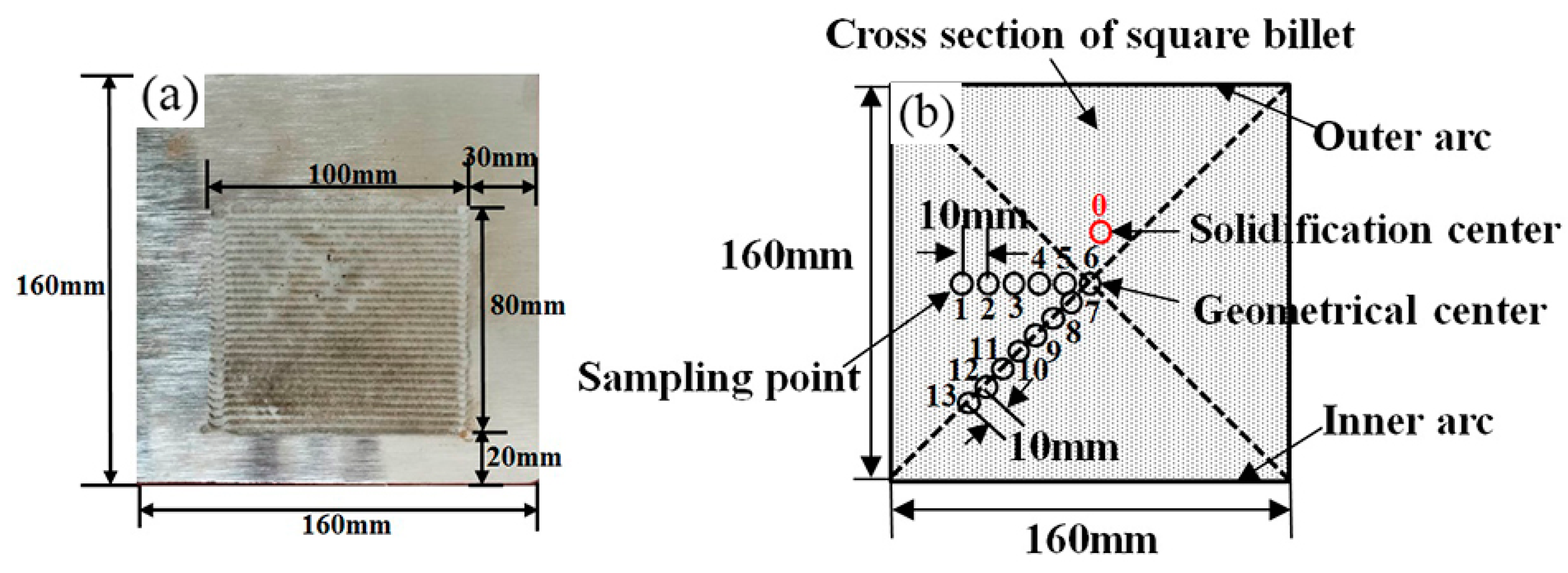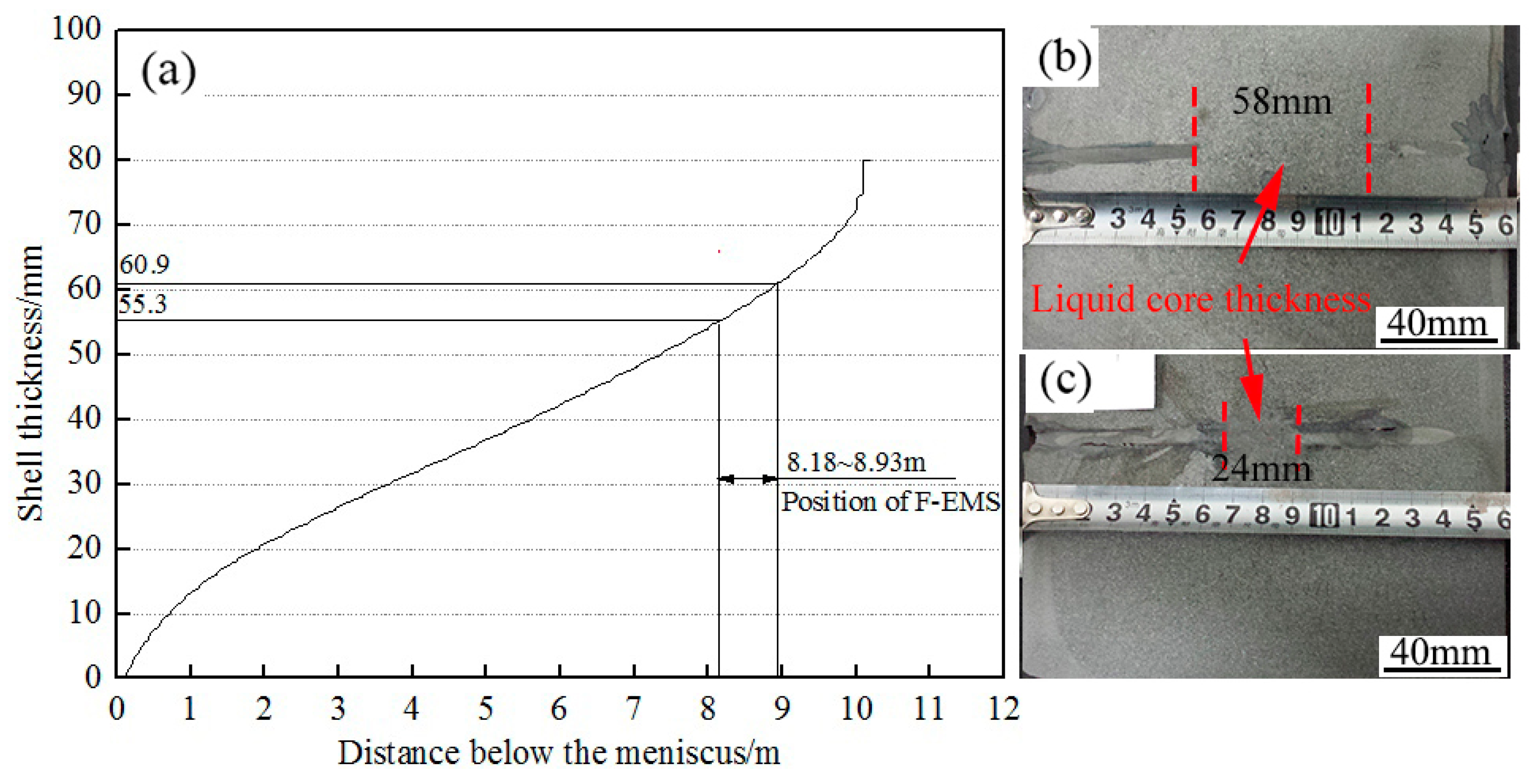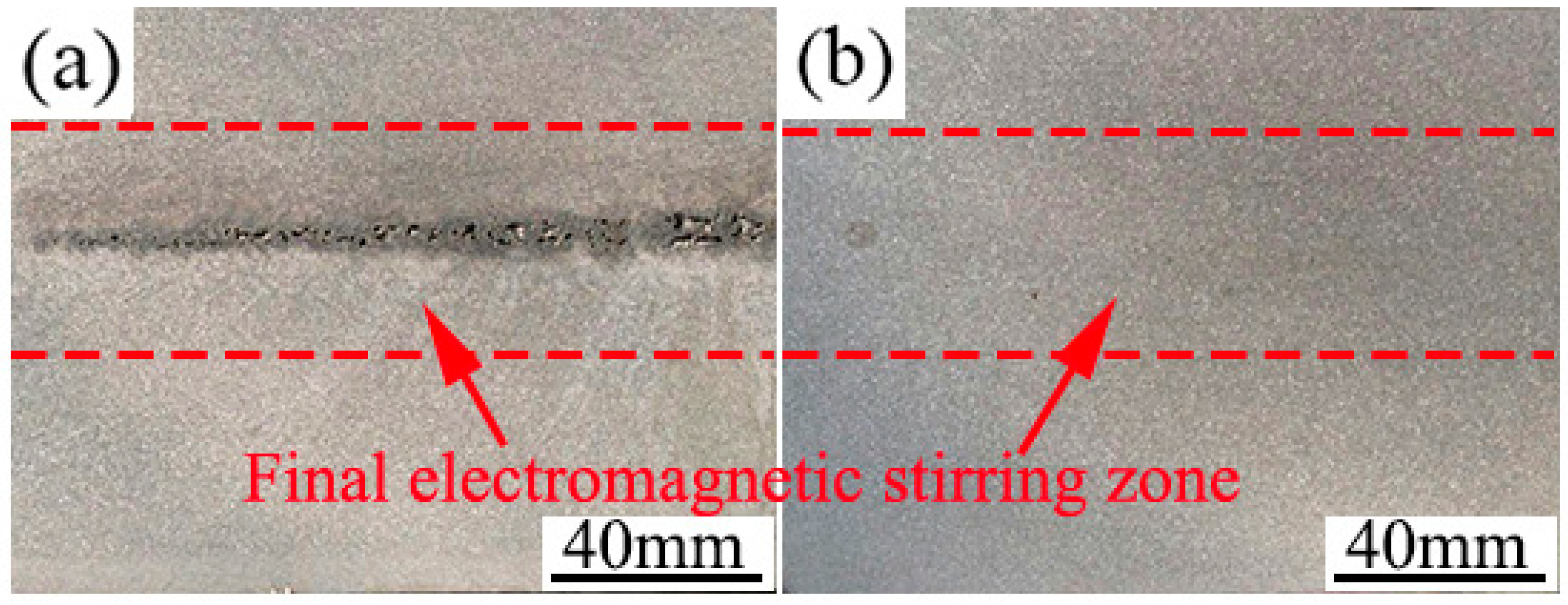Effect of Final Electromagnetic Stirring Parameters on Central Cross-Sectional Carbon Concentration Distribution of High-Carbon Square Billet
Abstract
:1. Introduction
2. Mathematical Model and Experimental Procedures
2.1. Electromagnetic Field Model
2.2. Experimental Procedures
3. Results and Discussion
3.1. Electromagnetic Forces of Final Electromagnetic Stirring (F-EMS) with Different Stirring Parameters
3.2. Effect of F-EMS Parameters on Central Cross-Sectional Carbon Concentration Distribution of Square Billet
3.3. Effect of F-EMS Parameters on Carbon Segregation of Cross Section of Square Billet
3.4. Effect of F-EMS on Internal Quality of Square Billet
4. Conclusions
- (1)
- With frequency increasing to 12 Hz, the current intensity can measure up to 280 A due to the fixed power of the electromagnetic stirrer.
- (2)
- The electromagnetic forces in the liquid zone of cross section at z = 112 mm and z = 336 mm are much larger than that at z = 0 mm and z = 224 mm. Along the center line of the liquid core zone, the electromagnetic force gradually decreases as the distance from the billet edge increases. The current intensity of 400 A and frequency of 8 Hz achieves the maximum electromagnetic force among the 10 groups of electromagnetic stirring parameters and is more liable to carry the enriched carbon element at the solid–liquid interface to the liquid core. Nevertheless, along the diagonal of the liquid core zone, the electromagnetic force near the diagonal center is the greatest and the current intensity of 280 A and frequency of 12 Hz obtains the maximum electromagnetic force.
- (3)
- The area ratio of carbon-medium concentration increases apparently in the middle of the billet cross section as the F-EMS current intensity and frequency increase to some extent. The optimal F-EMS parameter to make uniform the central cross-sectional carbon concentration and minimize the center carbon segregation of 70 steel billet has been obtained with a current intensity of 280 A and frequency of 12 Hz. Under this final electromagnetic stirring parameter, the area ratios of carbon concentrations of 0.66 wt%, 0.70 wt% and 0.74 wt% in the middle of the billet cross section are 28.5%, 56.9% and 10.9%, respectively. Moreover, the carbon segregation indexes for all the sampling points are in the range of 0.92–1.05.
Author Contributions
Funding
Acknowledgments
Conflicts of Interest
References
- Beckermann, C. Modelling of macrosegregation: Applications and future needs. Int. Mater. Rev. 2002, 47, 243–261. [Google Scholar] [CrossRef]
- Eskin, D.G.; Nadella, R.; Katgerman, L. Effect of different grain structures on centerline macrosegregation during direct-chill casting. Acta Mater. 2008, 56, 1358–1365. [Google Scholar] [CrossRef] [Green Version]
- Raihle, C.M.; Fredriksson, H. On the formation of pipes and centerline segregates in continuously cast billets. Metall. Mater. Trans. B 1994, 25, 123–133. [Google Scholar] [CrossRef]
- Yamazaki, M.; Natsume, Y.; Harada, H.; Ohsasa, K. Numerical simulation of solidification structure formation during continuous casting in Fe–0.7 mass% C alloy using cellular automaton method. ISIJ Int. 2006, 46, 903–908. [Google Scholar] [CrossRef]
- Power, P.; Yalamanchili, B.; Centa, T.; Lanham, D.; Boudreaux, T.; Boucier, T.; Hanchey, J. Importance of superheat and chemistry control for high carbon (1080) prestressed concrete grade steel. In Proceedings of the International Symposium on Near-Net-Shape Casting in the Minimills, Vancouver, BC, Canada, 19–23 August 1995; pp. 123–133. [Google Scholar]
- Stercken, K. Aspects of center segregation in high-carbon wire rod rolled from continuously cast billets. In Proceedings of the International Symposium on Near-Net-Shape Casting in the Minimills, Vancouver, BC, Canada, 19–23 August 1995; pp. 163–177. [Google Scholar]
- Ghosh, A. Principles of Secondary Processing and Casting of Liquid Steel; Raju Primlani: New Delhi, India, 1990. [Google Scholar]
- Sung, P.K.; Poirier, D.R.; Yalamanchili, B.; Geiger, G.H. Segregation of carbon and manganese in continuously cast high carbon steel for wire rod. Ironmak. Steelmak. 1990, 17, 424. [Google Scholar]
- Thome, R.; Harste, K. Principles of billet soft-reduction and consequences for continuous casting. ISIJ Int. 2006, 46, 1839–1844. [Google Scholar] [CrossRef]
- Ludlow, V.; Normanton, A.; Anderson, A.; Thiele, M.; Ciriza, J.; Laraudogoitia, J.; van der Knoop, W. Strategy to minimise central segregation in high carbon steel grades during billet casting. Ironmak. Steelmak. 2005, 32, 68–74. [Google Scholar] [CrossRef]
- Oh, K.S.; Chang, Y.W. Macrosegregation behavior in continuously cast high carbon steel blooms and billets at the final stage of solidification in combination stirring. ISIJ Int. 1995, 35, 866–875. [Google Scholar] [CrossRef]
- Du, W.-D.; Wang, K.; Song, C.-J.; Li, H.-G.; Jiang, M.-W.; Zhai, Q.-J.; Zhao, P. Effect of special combined electromagnetic stirring mode on macrosegregation of high strength spring steel blooms. Ironmak. Steelmak. 2008, 35, 153–156. [Google Scholar] [CrossRef]
- Suzuki, K.; Shinsho, Y.; Murata, K.; Nakanishi, K.; Kodama, M. Hot model experiments on electromagnetic stirring at about crater end of continuously cast bloom. Trans. Iron Steel Inst. Jpn. 1984, 24, 940–949. [Google Scholar] [CrossRef]
- Sun, H.; Zhang, J. Study on the macrosegregation behavior for the bloom continuous casting: Model development and validation. Metall. Mater. Trans. B 2014, 45, 1133–1149. [Google Scholar] [CrossRef]
- Luo, S.; Piao, F.-y.; Jiang, D.-b.; Wang, W.-l.; Zhu, M.-y. Numerical simulation and experimental study of F-EMS for continuously cast billet of high carbon steel. J. Iron. Steel Res. Int. 2014, 21, 51–55. [Google Scholar] [CrossRef]
- Jiang, D.; Zhu, M. Center segregation with final electromagnetic stirring in billet continuous casting process. Metall. Mater. Trans. B 2017, 48, 444–455. [Google Scholar] [CrossRef]
- Li, J.; Wang, B.; Ma, Y.; Cui, J. Effect of complex electromagnetic stirring on inner quality of high carbon steel bloom. Mater. Sci. Eng. A 2006, 425, 201–204. [Google Scholar] [CrossRef]
- Jiang, D.; Zhu, M. Solidification structure and macrosegregation of billet continuous casting process with dual electromagnetic stirrings in mold and final stage of solidification: A numerical study. Metall. Mater. Trans. B 2016, 47, 3446–3458. [Google Scholar] [CrossRef]
- Flemings, M.C. Our understanding of macrosegregation: Past and present. ISIJ Int. 2000, 40, 833–841. [Google Scholar] [CrossRef]
- Krauss, G. Solidification, segregation, and banding in carbon and alloy steels. Metall. Mater. Trans. B 2003, 34, 781–792. [Google Scholar] [CrossRef]














| Item | Value (Unit) |
|---|---|
| Number of turns | 150 |
| Current phase and phase difference of the magnetic stirring coil | 3 and 120° |
| Coil cross-sectional area | 4.8 × 10−3(m2) |
| Density of the liquid steel | 7000 (kg/m3) |
| Electrical resistivity of 70 steel | 1.6 × 10−6 (Ω·m) |
| Density of liquid steel | 7000 (kg/m3) |
| Viscosity of liquid steel | 5.5 × 10−3 (kg/m/s) |
| Electrical conductance of liquid steel | 7.14 × 106 (S/m) |
| Electrical conductance of air | 8.86 × 10−12 (S/m) |
| Electrical conductance of slab shell | 1.0 × 106 (S/m) |
| Electrical conductance of stainless steel | 1.33 × 106 (S/m) |
| Electrical conductance of iron core | 0 (S/m) |
| Relative magnetic permeability of liquid steel | 1 |
| Relative magnetic permeability of air | 1 |
| Relative magnetic permeability of slab shell | 1 |
| Relative magnetic permeability of stainless steel | 1 |
| Relative magnetic permeability of iron core | 1000 |
| C | Si | Mn | S | P | Als | Otol |
|---|---|---|---|---|---|---|
| 0.70 | 0.20 | 0.60 | 0.006 | 0.019 | 0.001 | 0.0023 |
© 2019 by the authors. Licensee MDPI, Basel, Switzerland. This article is an open access article distributed under the terms and conditions of the Creative Commons Attribution (CC BY) license (http://creativecommons.org/licenses/by/4.0/).
Share and Cite
Wan, Y.; Li, M.; Chen, L.; Wu, Y.; Li, J.; Pan, H.; Zhong, W. Effect of Final Electromagnetic Stirring Parameters on Central Cross-Sectional Carbon Concentration Distribution of High-Carbon Square Billet. Metals 2019, 9, 665. https://doi.org/10.3390/met9060665
Wan Y, Li M, Chen L, Wu Y, Li J, Pan H, Zhong W. Effect of Final Electromagnetic Stirring Parameters on Central Cross-Sectional Carbon Concentration Distribution of High-Carbon Square Billet. Metals. 2019; 9(6):665. https://doi.org/10.3390/met9060665
Chicago/Turabian StyleWan, Yong, Menghua Li, Liangjun Chen, Yichao Wu, Jie Li, Hongbo Pan, and Wei Zhong. 2019. "Effect of Final Electromagnetic Stirring Parameters on Central Cross-Sectional Carbon Concentration Distribution of High-Carbon Square Billet" Metals 9, no. 6: 665. https://doi.org/10.3390/met9060665




